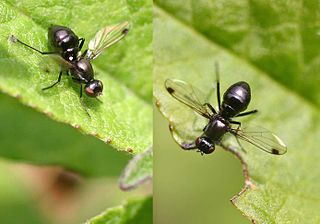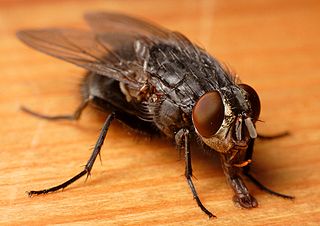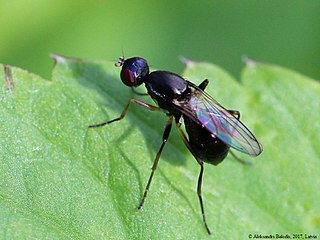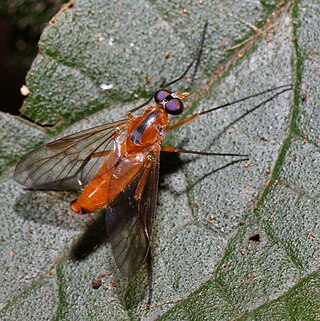| Toxopoda | |
|---|---|
| Scientific classification | |
| Domain: | Eukaryota |
| Kingdom: | Animalia |
| Phylum: | Arthropoda |
| Class: | Insecta |
| Order: | Diptera |
| Family: | Sepsidae |
| Subfamily: | Sepsinae |
| Genus: | Toxopoda Macquart, 1851 [1] |
| Type species | |
| Toxopoda nitida | |
| Synonyms | |
| Toxopoda | |
|---|---|
| Scientific classification | |
| Domain: | Eukaryota |
| Kingdom: | Animalia |
| Phylum: | Arthropoda |
| Class: | Insecta |
| Order: | Diptera |
| Family: | Sepsidae |
| Subfamily: | Sepsinae |
| Genus: | Toxopoda Macquart, 1851 [1] |
| Type species | |
| Toxopoda nitida | |
| Synonyms | |

The Sepsidae are a family of flies, commonly called the black scavenger flies or ensign flies. Over 300 species are described worldwide. They are usually found around dung or decaying plant and animal material. Many species resemble ants, having a "waist" and glossy black body. Many Sepsidae have a curious wing-waving habit made more apparent by dark patches at the wing end.

Cluster flies are flies of the genus Pollenia in the family Polleniidae. Unlike the more familiar blow flies, such as the bluebottle genus Phormia they do not lay eggs in human food. They parasitise earthworms; the females lay their eggs near earthworm burrows, and the larvae then feed on the worms. But the biology of this group is relatively poorly known and a few have been recorded from other hosts including caterpillars and bees.

Calliphora is a genus of blow flies, also known as bottle flies, found in most parts of the world, with the highest diversity in Australia. The most widespread species in North America are Calliphora livida, C. vicina, and C. vomitoria.

The Pyrgotidae are an unusual family of flies (Diptera), one of only two families of Cyclorrhapha that lack ocelli. Most species are "picture-winged", as is typical among the Tephritoidea, but unlike other tephritoids, they are endoparasitoids; the females pursue scarab beetles in flight, laying an egg on the beetle's back under the elytra where the beetle cannot reach it. The egg hatches and the fly larva enters the body cavity of the beetle, feeding and eventually killing the host before pupating. In the United States, some species of Pyrgota and Sphecomyiella can be quite common in areas where their host beetles are abundant. Like their host beetles, these flies are primarily nocturnal, and are often attracted to artificial lights.

Peleteria is a widespread genus of flies in the family Tachinidae.

Prosena is a genus of flies in the family Tachinidae.

Trupanea is a genus of tephritid or fruit flies in the family Tephritidae.

Actia is a genus of large flies in the family Tachinidae.

Rachispoda is a genus of flies belonging to the family Lesser Dung flies.
Cosmina is a genus of flies in the family Rhiniidae.
Brachythoracosepsis is a genus of flies in the family Sepsidae.
Archisepsis is a genus of flies in the family Sepsidae.
Dicranosepsis is a genus of flies in the family Sepsidae.

Meroplius is a genus of flies in the family Sepsidae.

Mucha is a genus of flies in the family Sepsidae.
Parapalaeosepsis is a genus of flies in the family Sepsidae.
Paratoxopoda is a genus of flies in the family Sepsidae.
Perochaeta is a genus of flies in the family Sepsidae.
Xenosepsis is a genus of flies in the family Sepsidae.

Suragina is a genus of flies in the family Athericidae.